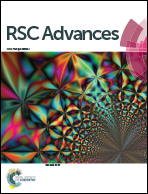A platinum nanowire network as a highly efficient current collector for intermediate temperature solid oxide fuel cells†
Abstract
We report the fabrication and evaluation of a platinum nanowire network as a highly efficient current collector for solid oxide fuel cells (SOFCs). The ink of carbon-black supported platinum nanoparticles was sprayed onto the cathode. After firing, the carbon black was oxidized and disappeared as carbon dioxide gas while the platinum nanoparticles connect with one another, forming a tree-branch-like nanowire network. The diameters of the nanowires range from 100 nm to 400 nm. Compared to a conventional platinum paste current collector, the polarization resistance of the PrBaCo2O5+δ (PBCO) cathode with a nanowire current collector was reduced by 44% at 650 °C (from 0.18 Ω cm2 to 0.1 Ω cm2). The peak power density of the button cells was improved at different degrees of 31.8–59.6% under temperatures 650–550 °C for typical cathode materials of PBCO, La0.6Sr0.4Co0.2Fe0.8O3−δ (LSCF), and Ba0.5Sr0.5Co0.8Fe0.2O3−δ (BSCF). The nanowire network did not show obvious changes after long term testing (400 h).


 Please wait while we load your content...
Please wait while we load your content...